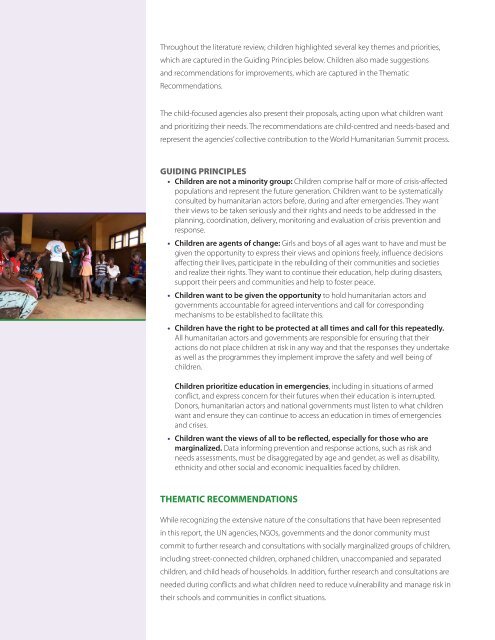putting-children-at-the-heart_full_text_final
putting-children-at-the-heart_full_text_final
putting-children-at-the-heart_full_text_final
- No tags were found...
You also want an ePaper? Increase the reach of your titles
YUMPU automatically turns print PDFs into web optimized ePapers that Google loves.
Throughout <strong>the</strong> liter<strong>at</strong>ure review, <strong>children</strong> highlighted several key <strong>the</strong>mes and priorities,<br />
which are captured in <strong>the</strong> Guiding Principles below. Children also made suggestions<br />
and recommend<strong>at</strong>ions for improvements, which are captured in <strong>the</strong> Them<strong>at</strong>ic<br />
Recommend<strong>at</strong>ions.<br />
The child-focused agencies also present <strong>the</strong>ir proposals, acting upon wh<strong>at</strong> <strong>children</strong> want<br />
and prioritizing <strong>the</strong>ir needs. The recommend<strong>at</strong>ions are child-centred and needs-based and<br />
represent <strong>the</strong> agencies’ collective contribution to <strong>the</strong> World Humanitarian Summit process.<br />
GUIDING PRINCIPLES<br />
• Children are not a minority group: Children comprise half or more of crisis-affected<br />
popul<strong>at</strong>ions and represent <strong>the</strong> future gener<strong>at</strong>ion. Children want to be system<strong>at</strong>ically<br />
consulted by humanitarian actors before, during and after emergencies. They want<br />
<strong>the</strong>ir views to be taken seriously and <strong>the</strong>ir rights and needs to be addressed in <strong>the</strong><br />
planning, coordin<strong>at</strong>ion, delivery, monitoring and evalu<strong>at</strong>ion of crisis prevention and<br />
response.<br />
• Children are agents of change: Girls and boys of all ages want to have and must be<br />
given <strong>the</strong> opportunity to express <strong>the</strong>ir views and opinions freely, influence decisions<br />
affecting <strong>the</strong>ir lives, particip<strong>at</strong>e in <strong>the</strong> rebuilding of <strong>the</strong>ir communities and societies<br />
and realize <strong>the</strong>ir rights. They want to continue <strong>the</strong>ir educ<strong>at</strong>ion, help during disasters,<br />
support <strong>the</strong>ir peers and communities and help to foster peace.<br />
• Children want to be given <strong>the</strong> opportunity to hold humanitarian actors and<br />
governments accountable for agreed interventions and call for corresponding<br />
mechanisms to be established to facilit<strong>at</strong>e this.<br />
• Children have <strong>the</strong> right to be protected <strong>at</strong> all times and call for this repe<strong>at</strong>edly.<br />
All humanitarian actors and governments are responsible for ensuring th<strong>at</strong> <strong>the</strong>ir<br />
actions do not place <strong>children</strong> <strong>at</strong> risk in any way and th<strong>at</strong> <strong>the</strong> responses <strong>the</strong>y undertake<br />
as well as <strong>the</strong> programmes <strong>the</strong>y implement improve <strong>the</strong> safety and well being of<br />
<strong>children</strong>.<br />
Children prioritize educ<strong>at</strong>ion in emergencies, including in situ<strong>at</strong>ions of armed<br />
conflict, and express concern for <strong>the</strong>ir futures when <strong>the</strong>ir educ<strong>at</strong>ion is interrupted.<br />
Donors, humanitarian actors and n<strong>at</strong>ional governments must listen to wh<strong>at</strong> <strong>children</strong><br />
want and ensure <strong>the</strong>y can continue to access an educ<strong>at</strong>ion in times of emergencies<br />
and crises.<br />
• Children want <strong>the</strong> views of all to be reflected, especially for those who are<br />
marginalized. D<strong>at</strong>a informing prevention and response actions, such as risk and<br />
needs assessments, must be disaggreg<strong>at</strong>ed by age and gender, as well as disability,<br />
ethnicity and o<strong>the</strong>r social and economic inequalities faced by <strong>children</strong>.<br />
THEMATIC RECOMMENDATIONS<br />
While recognizing <strong>the</strong> extensive n<strong>at</strong>ure of <strong>the</strong> consult<strong>at</strong>ions th<strong>at</strong> have been represented<br />
in this report, <strong>the</strong> UN agencies, NGOs, governments and <strong>the</strong> donor community must<br />
commit to fur<strong>the</strong>r research and consult<strong>at</strong>ions with socially marginalized groups of <strong>children</strong>,<br />
including street-connected <strong>children</strong>, orphaned <strong>children</strong>, unaccompanied and separ<strong>at</strong>ed<br />
<strong>children</strong>, and child heads of households. In addition, fur<strong>the</strong>r research and consult<strong>at</strong>ions are<br />
needed during conflicts and wh<strong>at</strong> <strong>children</strong> need to reduce vulnerability and manage risk in<br />
<strong>the</strong>ir schools and communities in conflict situ<strong>at</strong>ions.


